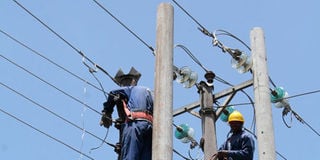High energy, labour costs bane of industrial growth

Kenya Power technicians at work.
What you need to know:
- Investors now prefer Ethiopia to Kenya because the former’s costs of production are comparatively lower
High costs of energy and labour are emerging as the toughest hurdles Kenya faces in its efforts to industrialise.
This has made the country less attractive than its neighbours to investors.
Increased investment is a key pillar of Vision 2030 blueprint, which aims to achieve a middle-income economy with a thriving industrial sector.
In this year’s budget, Sh3 billion was set to revamp both textile and leather industries. However, costly labour and energy are hampering that plan.
Investors in Kenya pay between 18 and 22 US cents per kilowatt hour against 3 and 5 US cents in Ethiopia’s. This clearly puts Nairobi at a disadvantage.
Last year, Jiangsu Lianfa Textile Company of China held talks with the Ministry of Industrialisation as reports filtered that Ethiopia was also courting the same firm.
Jiangsu wanted Kenya to provide about 50,000 hectares to grow cotton and a further 170,000 square metres for its textile plant.
The company was eyeing the Rift Valley that has geothermal plants in order to enjoy low energy costs. Jiangsu had promised to employ about 30,000 people within two years. The deal is still in the works.
Express concern
Jiangsu is associated with top firms such as New-York-headquartered PVH Corp, owner of Calvin Klein brand, and North Carolina-based VF that owns Lee Jeans and Timberland footwear. Both PVH and VF expressed concerns over Kenya’s high energy costs.
The government introduced subsidised energy cost in July 2014 for selected industries that met certain benchmarks.
“The companies that met contribution of 30 per cent to the employment and exports were granted 50 per cent reduction in energy cost. They buy energy at 8.5 US cents per kilowatt hour,” said Export Processing Zone Authority chief executive, Mr Cyrille Nabutola.
The government has also set an ambitious plan to produce 5,000MW by 2017, as a way of cutting the cost of electricity.
The frequent agitation for higher pay by sector workers is also another concern. Some investors view Kenya’s labour policy as unpredictable. Currently, the minimum wage in Kenya is more than three times that of Ethiopia.
Only last week, 7,000 workers in three textile factories in Mombasa — Ashton Apparel, MK Apparel and Mombasa Apparel — downed tools demanding higher pay.
“We want to make it clear that we have to remain competitive. The cost of labour in America and Asia has gone up and investors are coming to developing countries such as Kenya and we want the country to benefit,” said Industrialisation Cabinet secretary Adan Mohamed.
“The labour cost in Kenya is the highest in sub-Saharan Africa at $150 compared to between $40 and $60 in other countries.”
The government is also lagging behind in establishing special economic zones to host big industries.
The law governing export processing zones has restricted to 20 per cent the quantity of products that industries located in these areas can sell locally, a market that now comprises the East Africa Community bloc.
The special economic zones will lead to increase in the threshold of the volume of products that can be sold in the bloc.
The law has remained unchanged for years despite the government’s stated desire to set up the zones to spur industrial growth.
China has already indicated that a number of companies would be willing to open branches in Kenya in response to the increasing cost of labour in Beijing but experts are concerned that the lack of a wage policy is likely to push such firms to neighbouring Ethiopia.
Cluster of related firms
“Industrial relocation from neighbouring countries such as Japan is how China took-off and Kenya can benefit from it. China stands to share experiences on industrial and special economic zones,” said China foreign affairs minister, Mr Wang Yi, when he visited Kenya recently.
Mr Nabutola said the labour cost in Kenya is high because of the level of minimum basic wage.
The government is however finding ways to tame the sky-high costs. It is for instance working on establishing leather and textile cities.
The objective is to bring together related companies in order to cut cost of production by providing infrastructure such as water, roads, sewage and energy collectively.
A leather industry city is to be set up on a 500-acre EPZA land at Kinanie, in Athi River, Machakos County.
The processing centre is expected to cut the export of wet blue (semi-processed) leather currently at 90 per cent and increase the supply of shoes, belts, hand-bags among other finished products.
The government expects this to increase the sector’s contribution to the economy to Sh100 billion from Sh10 billion in about four years.
The government will provide water and energy effluent plant at a cost of Sh7 billion. Firms are expected to ride on the facility to establish manufacturing units.
“This way, we should be able to see more investors in the sector, more players moving from the export of wet blue to finished products and more small and medium enterprises making leather products,” he said.
Preferential treatment
There are 15 tanneries spread across the country, and the government’s intention is to have them operate from one area where other related companies including the small and medium manufacturing units will be established.
The first phase of the project will target 15 tanneries, each with a production capacity of 10 tonnes of raw hides and skins a day and at least 10,000 pairs of shoes, handbags, leather garments and industrial gloves.
Industrialisation minister said the growth of the industry was slowed down by initial huge investment capital requirements that include water, power, and effluent treatment.
This hindered investors from going into manufacturing of finished products.
The government last year came up with a policy to give preferential treatment to local goods in procurement.





